![]()
![]()
![]()
Use LEFT and RIGHT arrow keys to navigate between flashcards;
Use UP and DOWN arrow keys to flip the card;
H to show hint;
A reads text to speech;
98 Cards in this Set
- Front
- Back
|
Groups of cells similar in structure and function.
4 types of tissues in human body : |
Epithelial tissue: covering/lining.
Connective tissue: support. Muscle tissue: movement. (Cardiac, smooth, skeletal). Nerve tissue: regulation/ control. |
|
|
When examining types of epithelial tissues under a light microscope, you are practicing ___________.
a. Histology. b. Electron microscopy. c. Tissue regeneration. d. Cytology. e. Embryology. |
a. Histology.
|
|
|
Nervous Tissue: Internal communication.
|
Brain, spinal chord, and nerves.
|
|
|
Muscle tissue: contracts to cause movement.
|
Muscles attached to bones (skeletal). Muscles of heart (cardiac). Muscles of walls of hollow organs (smooth).
|
|
|
Epithelial tissue: forms boundaries between different environments, protects, secretes, absorbs, filters.
|
Skin surface (epidermas). Lining of GI tract organs and other hollow organs.
|
|
|
Connective tissue: supports, protects, binds other tissues together.
|
Bones, tendons, fat and other soft padding tissue.
|
|
|
Which of the following best describes a tissue?
a. A group of organs working together for a common purpose. b. A group of cells that have a similar structure and function. c. The collection of all organelles in a cell. d. Organs such as the heart or liver. |
b. A group of cells that have a similar structure and function.
|
|
|
Which of the following relationships between a tissue and it's general function is not correct?
a. Epithelial: digestion. b. Connective: support. c. Muscle: movement. d. Nervous: control. |
Yeshiva of
|
|
|
Two types of epithelial tissue (epithelium)
|
Linings and coverings epithelia and glandular epithelia.
|
|
|
Lining and covering epithelia
|
Lines body cavities and covers internal organs. Forms external and internal linings of surfaces. 🔸Example: covers skin and forms outer lining of internal organs such as heart, lungs, urinary tract; forms inner linings of body cavities, blood vessels, and other hollow organs.
|
|
|
Which of the following tissue types would you expect to find on a surface of the body that is subjected to a friction?
a. Epithelial tissue. b. Connective tissue. c. Muscle tissue. d. Nervous tissue. |
a. Epithelial tissue.
|
|
|
An area in the body exposed to the external environment would be composed of which of the following tissue types?
a. Epithelial tissue. b. Connective tissue. c. Muscle tissue. d. Nervous tissue. |
a. Epithelial tissue.
|
|
|
2 layers of epithelia
|
1=simple epithelium.
>1=stratified epithelium. |
|

|
Simple epithelium
|
|

|
Stratified epithelium
|
|
|
What is the cell shapes of epithelia?
|
Squamous, cuboidal, and columnar.
🔸(Is stratified, name according to apical layer of cells.) |
|
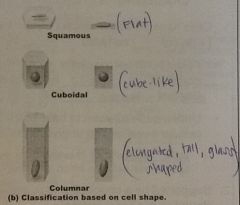
|
Epithelia cell shapes
|
|
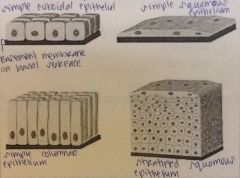
|
Epithelial tissue
|
|
|
characteristics of epithelial tissue (5)
|
🔺Cells have polarity- apical (free) and basal (attached) surfaces.
🔺Apical surfaces may bear microvilli (surface area for absorption) 🔸examples: brush border of GI lining. or cilia 🔸examples: lining of trachea. Underneath/adjacent to basal surface is non-cellular basal lamina of glycoprotein and collagen. 🔹basal lamina= layer of extracellular matrix secreted by epithelial cells, on which epithelium sits. |
|
|
characteristics of epithelial tissue (5)
|
🔺supported by a connective tissue reticular lamina (found under basal lamina)
|
|
|
characteristics of epithelial tissue (5)
|
🔺are composed of closely packed cells. (Fusing of membranes)
🔹continuous sheets held together by tight junctions and desmosomes (cell structure specialized for cell-to-cell adhesion) HIGH CELL RATIO. |
|
|
characteristics of epithelial tissue (5)
|
Avascular but innervated
🔺avascular- without blood vessels. 🔺innervated- with nerves. |
|
|
Simple squamous epithelium: Location.
|
Kidney glomerull; air sacs of lungs; lining of heart, blood vessels, and lymphatic vessels; lining of ventral body cavity (serosae).
|
|
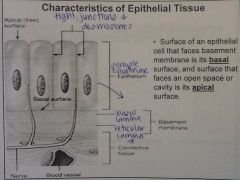
|
Characteristics of epithelial tissue.
|
|
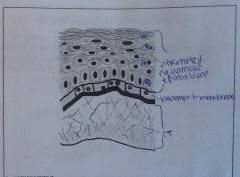
|
Stratified squamous epithelium.
|
|
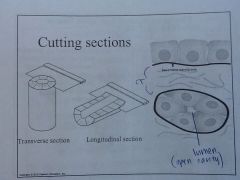
|
Cutting sections.
|
|
|
Which of the following specialized terms reflects the epithelial tissue found lining the inside of blood and lymph vessels?
a. Epithelium b. Endothelium c. Mesothelium d. Squathelium |
b. Endothelium
|
|
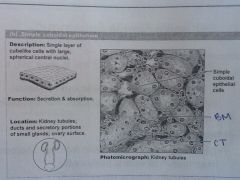
|
Simple cuboidal epithelium
|
|

|
Simple squamous epithelium
|
|
|
Simple cuboidal epithelium: function
|
Secretion and absorption
|
|
|
Simple cuboidal epithelium: location
|
Kidney tubules; ducts and secretory portions of small glands; ovary surface.
|
|
|
Simple columnar epithelium
|
Simple columnar epithelium.
🔺ciliated variety: uterine tubes, uterus (reproductive cells), bronchi (mucus). 🔺non-ciliated variety: GI tract. |
|
|
characteristics of epithelial tissue (5)
|
High rate of regeneration
|
|
|
Simple columnar epithelium: description
|
Single layer or talk cells with round to oval nuclei; some cells bear cilia; may contain mucus-secreting unicellular glands (goblet cells).
|
|
|
Simple columnar epithelium: function
|
Absorption, secretion of mucus and enzymes.
|
|
|
Simple columnar epithelium: location
|
Non ciliated type of lines most of digestive tract (stomach to anal canal) and gallbladder; ciliated variety lines bronchi, uterine tubes, and uterus.
|
|
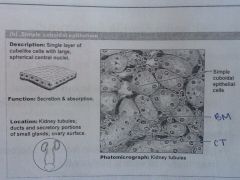
|
Simple cuboidal epithelium
|
|
|
Pseudostratified columnar epithelium: Description
|
Single layer of cells of differing heights, some not reaching free surface; nuclei seen at different levels; may contain mucus-secreting cells and bear cilia.
|
|
|
Pseudostratified columnar epithelium: function
|
Secretion of mucus; propulsion of mucus by ciliary action.
|
|
|
Pseudostratified columnar epithelium: location
|
Non-ciliated type in male's sperm carrying ducts and ducts of large glands; ciliated variety lines trachea, most upper respiratory tract.
|
|
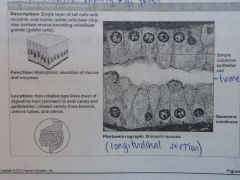
|
Simple columnar epithelium.
🔺ciliated variety: uterine tubes, uterus (reproductive cells), bronchi (mucus). 🔺non-ciliated variety: GI tract. |
|
|
Pseudostratified columnar epithelium: ciliated variety
|
Upper respiratory tract (propels mucus).
|
|

|
Stratified squamous epithelium
|
|
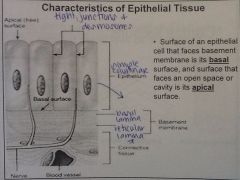
|
Characteristics of epithelial tissue.
|
|
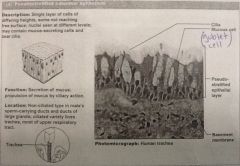
|
Pseudostratified columnar epithelium
|
|
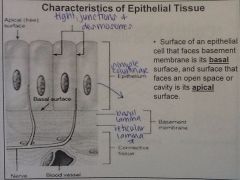
|
Cutting sections.
|
|
|
The basal almond is associated with which type of tissue?
a. Epithelial tissue. b. Connective tissue. c. Nervous tissue. d. Muscle tissue. |
a. Epithelial tissue.
|
|
|
With which portion of an epithelia cell in the stomach would food be in contact?
a. Basal surface. b. Apical surface. c. Basal lamina. d. Reticular lamina. |
b. Apical surface.
|
|
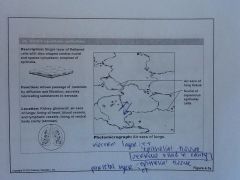
|
Simple squamous epithelium
|
|
|
Simple squamous epithelium: Description
|
Single layer of flattened cells with disc-shaped central nuclei and sparse cytoplasm; simplest of epithelia.
|
|

|
Stratified squamous epithelium
|
|
|
Stratified squamous epithelium: description
|
Thick membrane composed of several cell layers; basal cells are cuboidal or columnar and metabolically active; surface cells are flattened (squamous); in keratinized type, surface cells are full of keratin and dead; basal cells if the more superficial layers.
|
|
|
Stratified squamous epithelium: function
|
Protects underlying tissues in areas subjected to abrasion.
|
|
|
Stratified squamous epithelium: location
|
Non-keratinized type forms moist linings of esophagus, mouth, and vagina; keratinized variety forms epidermis of skin, a dry membrane.
|
|
|
Stratified squamous epithelium: keratinized
|
(Dead) stratified squamous epi: skin.
|
|
|
Stratified squamous epithelium: non-keratinized
|
(Living) stratified squamous epi: esophagus, vagina canal, oral cavity.
|
|

|
Keratinized stratified squamous epithelium
|
|
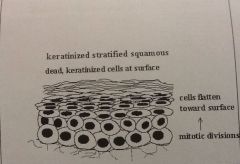
|
Keratinized stratified squamous
|
|
|
Which characteristic of epithelial tissues would you expect to find in a duct that is subject to a high degree of pressure (such as the male urethra)?
Cuboidal shape. Simple layering. Pseudostratified layering. Stratified layering. |
Stratified layering.
|
|
|
Rare stratified columnar epithelium: function
|
Protection; secretion
|
|
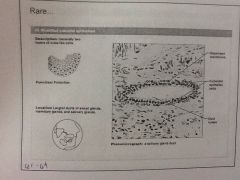
|
Rare stratified cuboidal epithelium
|
|
|
|
Transitional epithelium.
|
|
|
Transitional epithelium: description
|
Resembles both stratified squamous and stratified cuboidal; basal cells cuboidal or columnar; surface cells dome shaped or squamous like, depending on degree of organ stretch.
|
|
|
Transitional epithelium: function
|
Stretches readily and permits distension of urinary organ by contained urine.
|
|
|
Transitional epithelium: location
|
Lines ureters, urinary bladder, and part of the urethra.
|
|
|
Glandular epithelia
|
A gland is one of more cells that synthesizes and secretes a substance such as hormones or aqueous fluid.
|
|
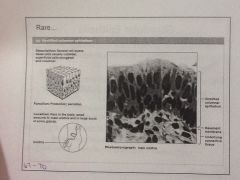
|
Rare stratified columnar epithelium
|
|
|
Glandular epithelia: classified by relative number of cells forming gland:
|
Unicellular is comprised of only one epithelial cell. Multicellular multiple epithelial cells comprise one gland.
|
|
|
Glandular epithelia
|
Unicellular exocrine gland.
Unicellular endocrine gland. Multicellular exocrine gland. Multicellular endocrine gland. |
|
|
Epithelia: stratified cuboidal
|
Quite rare in the body. Found in some sweat, mammary, and salivary glands. Typically 2 cell layers thick.
|
|

|
Transitional epithelium.
|
|
|
Unicellular endocrine gland
|
Enteroendocrine cells of GI tract , leydig cells. (Male reproductive)
|
|
|
Multicellular exocrine gland
|
Salivary, sweat, sebaceous glands. (Oil glands)
|
|
|
Multicellular endocrine glands.
|
Pituitary, thyroid, adrenal gland.
|
|
|
|
Multicellular exocrine and endocrine glands
|
|
|
The major distinction between endocrine glands and exocrine glands is that endocrine glands secrete their product into ________.
The blood. A duct. The stomach. The bladder. |
The blood
|
|
|
The presence of which type of epithelial tissue is a dead giveaway for glands?
Simple squamous Stratified squamous. Transitional epithelium. Simple cuboidal |
Simple cuboidal
|
|
|
|
Rare stratified cuboidal epithelium
|
|
|
Rare stratified cuboidal epithelium: description
|
Generally two layers of cube-like cells.
|
|
|
Rare stratified cuboidal epithelium: function
|
Protection.
|
|
|
Rare stratified cuboidal epithelium:location
|
Largest ducts of sweat glands, mammary glands, and salivary glands.
|
|
|
Which of the following types of epithelial tissues is best suited for areas of the body where diffusion or filtration occurs?
Stratified columnar. Simple cuboidal. Simple squamous. Stratified squamous. |
Simple squamous.
|
|
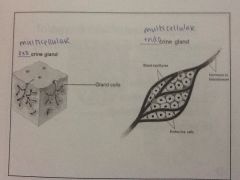
|
Multicellular exocrine and endocrine glands
|
|
|
|
Rare stratified columnar epithelium
|
|
|
Rare stratified columnar epithelium: description
|
Several cell layers; basal cells usually cuboidal; superficial cells elongated and columnar
|
|
|
Endocrine glands
|
Ductless glands. Secrete hormones that travel directly through blood to target organs. Regulates body's homeostasis and metabolism.
Examples include thyroid and adrenal gland. Cortisol (stress hormone) secretes by adrenal gland helps to maintain blood pressure, immune function, and body's anti-inflammatory processes. |
|
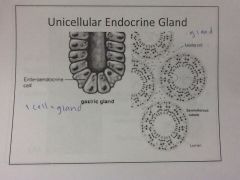
|
Unicellular Endocrine gland
|
|
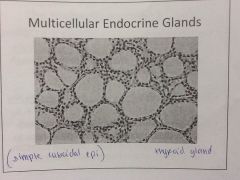
|
Multicellular endocrine glands
|
|
|
Multicellular exocrine glands classified according to:
|
Duct type:
|
|
|
|
Unicellular Endocrine gland
|
|
|
|
Multicellular endocrine glands
|
|
|
Exocrine glands
|
More numerous than endocrine glands. Secretions released onto body surfaces (skin) via ducts or into body cavities that lead to external environment. Examples include mucous, sweat, oil, and salivary glands.
|
|
|
Unicellular exocrine glands
|
Only important unicellular exocrine gland is goblet cell, a mucus-secreting, column-shaped cell.
|
|
|
Unicellular exocrine glands: respiratory tract
|
Mucus coats epithelium of vulnerable structures to provide protection from chemical/mechanical damage and to trap invading pathogens.
|
|
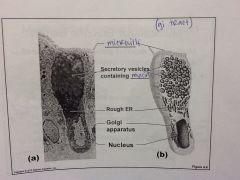
|
GI tract
|
|
|
Unicellular exocrine glands: goblet cells contain- mucin
|
Group of glycoprotein that forms viscous solutions; forms main constituent of mucus. (Thickness)
|
|
|
Unicellular exocrine glands: goblet cells contain-microvilli
|
Minute, finger-like structures projecting from surface of epithelial cells; increase surface area available for absorbing nutrients. (To GI tract exclusive)
|
|
|
|
GI tract
|

